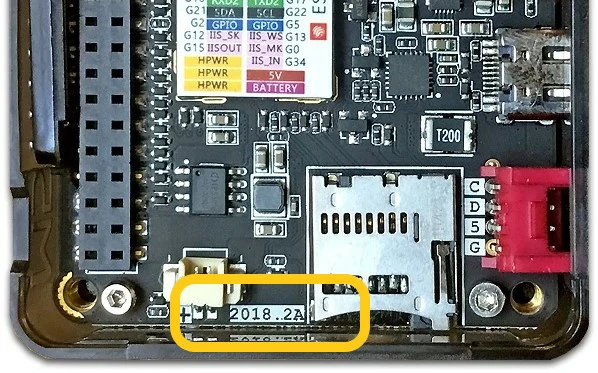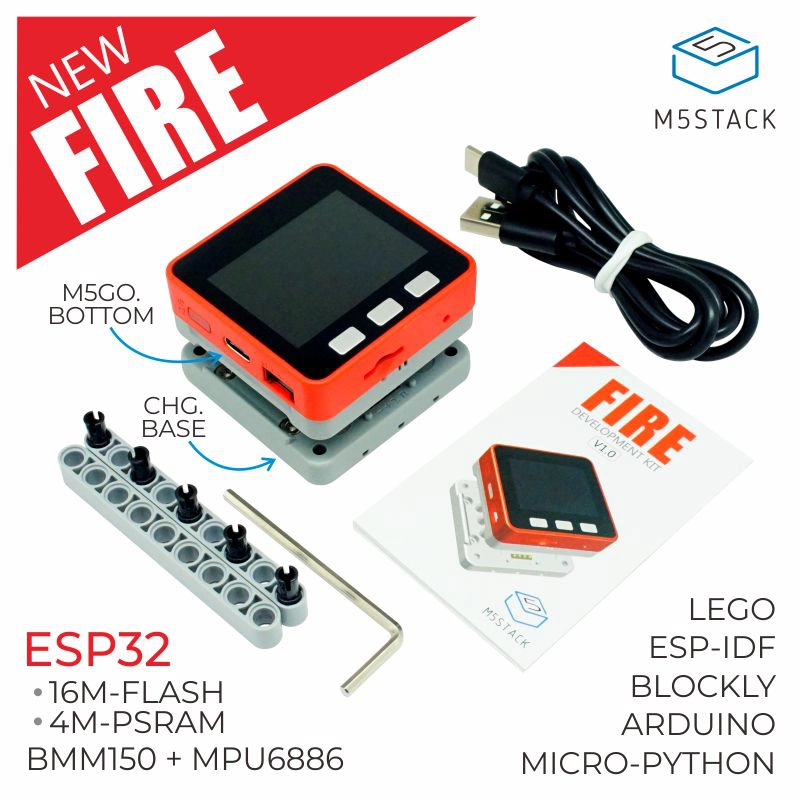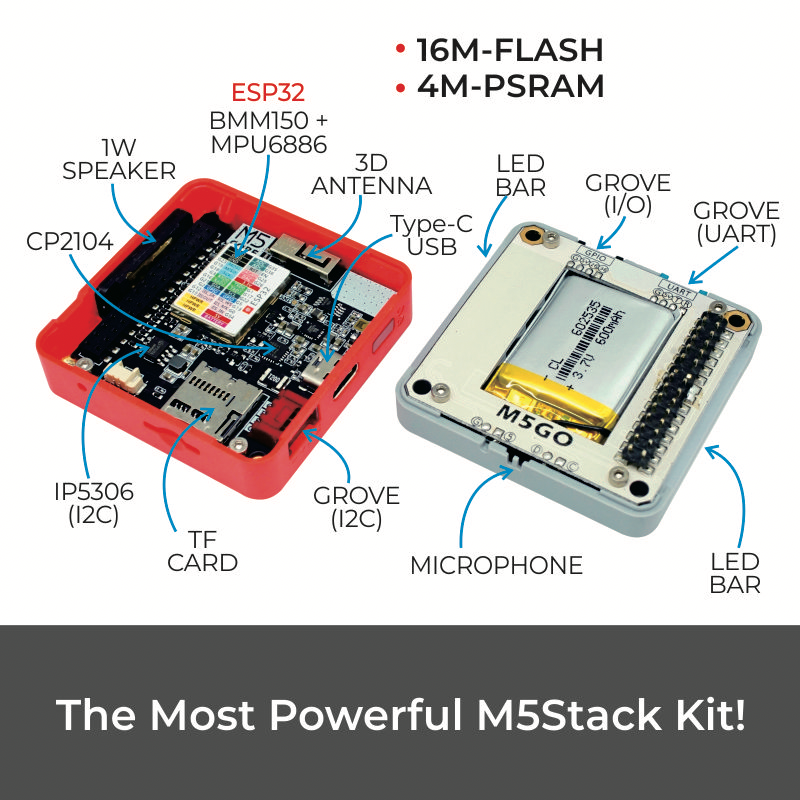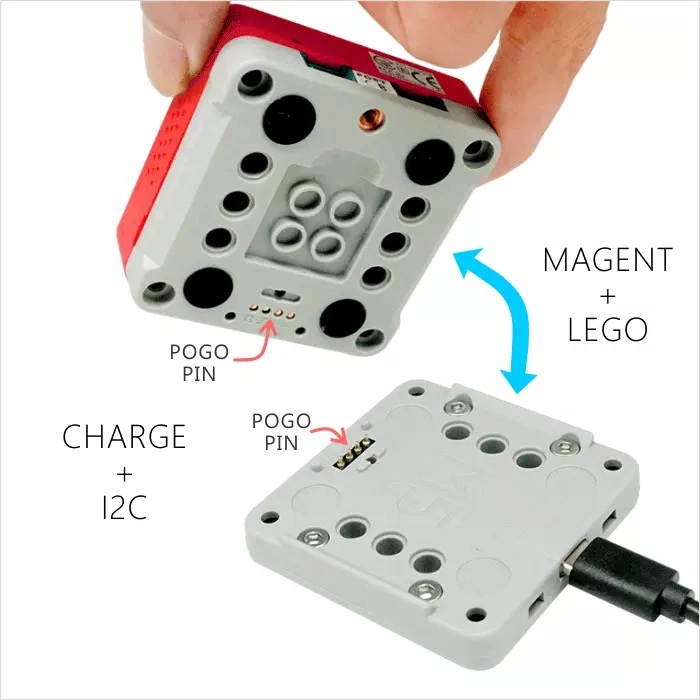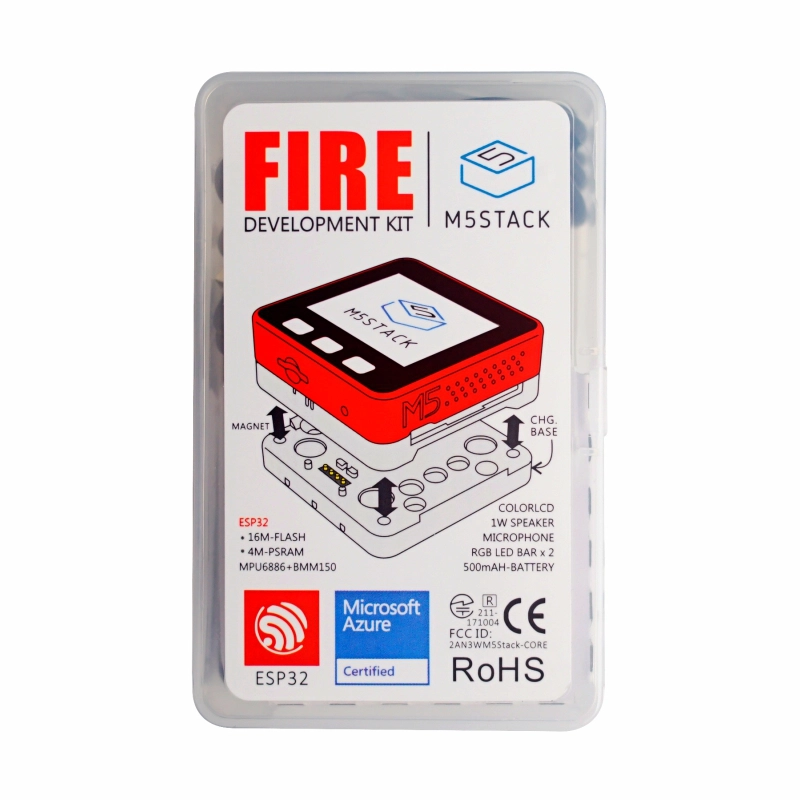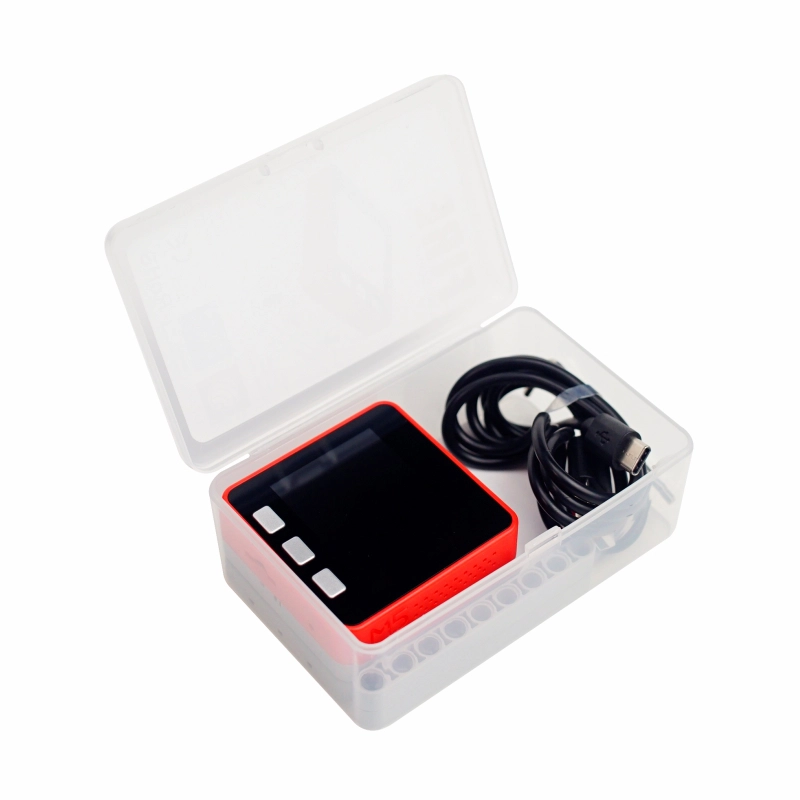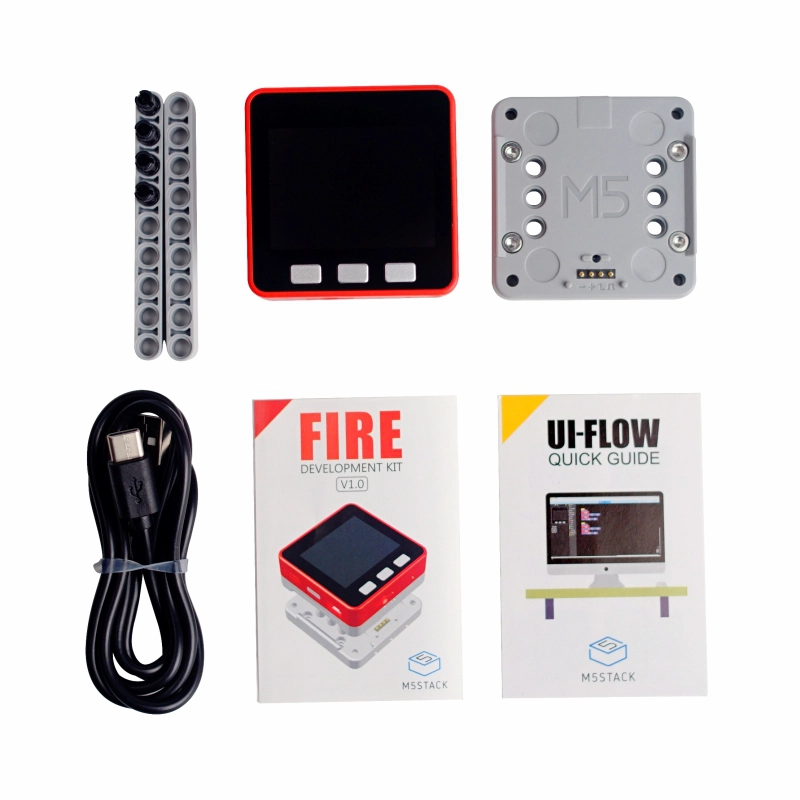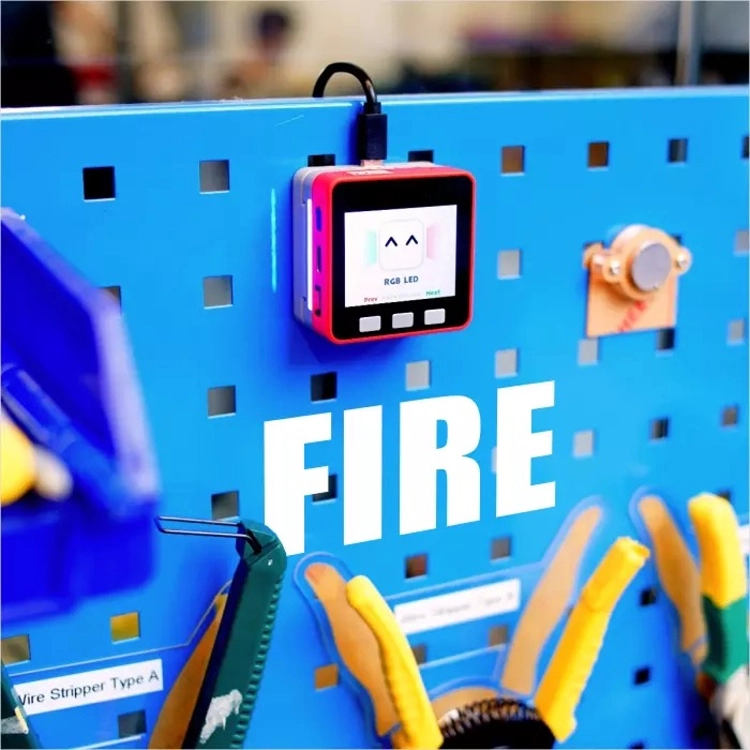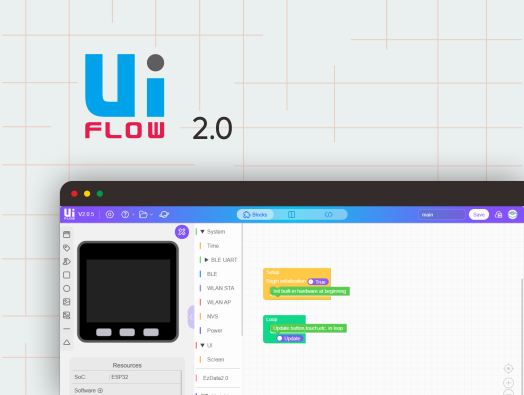Fire
SKU:K007
Description
Fire is a high-performance development kit in the M5Stack series. As an upgraded version of the Gray kit, it features a nine-axis motion sensor (six-axis accelerometer + three-axis magnetometer) and enhanced hardware resources: 16MB Flash, 8MB PSRAM, an enhanced Base (M5GO base and M5GO charging base), and a larger capacity battery. For developers with demanding hardware performance requirements, Fire is an excellent choice.
The motion sensor can be used in various applications to detect acceleration, angle, trajectory extension, and other data. Based on these, related products such as motion data collectors and 3D remote gesture controllers can be developed.
Fire consists of three detachable parts. The top part, like other M5 hosts, contains the circuit board, chips, LCD screen, 2.4G antenna, various electronic components, and interface components. The middle part is called the M5GO base, which provides a lithium battery, M5-Bus socket, LED strip, and three GROVE expansion ports. The bottom part is the charging base, which can be connected to the M5GO base via POGO pins for charging.
Tutorial
This tutorial will introduce how to control the Fire device through the UiFlow graphical programming platform.
This tutorial will introduce how to control the Fire device through the UiFlow2 graphical programming platform.
This tutorial will introduce how to control the Fire device through the Arduino IDE.
Features
- Based on ESP32 development
- External PSRAM
- Integrated 3-axis gyroscope, 3-axis accelerometer, and 3-axis magnetometer
- Built-in speaker, buttons, LCD screen, power/reset buttons
- TF card slot (supports up to 16GB)
- Built-in lithium battery
- Magnetic back design
- Expandable pins and interfaces
- M5-Bus socket
- Development Platform
- UiFlow1
- UiFlow2
- Arduino IDE
- ESP-IDF
- PlatformIO
Includes
- 1 x FIRE
- 1 x M5GO Charging Base
- 2 x LEGO Bricks
- 5 x LEGO Connectors
- 1 x M3 Hex Wrench
- 1 x USB Type-C Cable (100cm)
- 1 x User Manual
Applications
- IoT Controller
- STEM Education
- DIY Projects
- Smart Home Devices
Specifications
| Main Control Resources | Parameter |
|---|
| SoC | ESP32-D0WDQ6@Dual-core processor, Main frequency 240MHz |
| DMIPS | 600 |
| SRAM | 520KB |
| Flash | 16MB |
| PSRAM | 8MB |
| Wi-Fi | 2.4 GHz Wi-Fi |
| Input Voltage | 5V@500mA |
| Host Interface | USB Type-C x 1, GROVE (I2C+I/O+UART) x 1 |
| IPS Screen | 2 inch, 320x240 Colorful TFT LCD, ILI9342C, Max brightness 853nit |
| Speaker | 1W-0928 |
| Microphone | MEMS Analog BSE3729 Microphone |
| LED | SK6812 3535 RGB LED x 10 |
| MEMS | BMM150 + SH200Q/MPU6886 |
| Antenna | 2.4G 3D antenna |
| Base Interface | PortA (I2C), PortB (GPIO), PortC (UART) |
| Battery | 500mAh@3.7V, inside vb |
| Operating Temperature | 0 ~ 60°C |
| Case Material | Plastic (PC) |
| Product Size | 54.0 x 54.0 x 28.6mm |
| Product Weight | 62.6g |
| Package Size | 106.7 x 69.1 x 40.4mm |
| Gross Weight | 123.8g |
Learn
BMM150 Magnetic Field Interference
Products with magnets may interfere with the BMM150 magnetic field sensor, causing abnormal readings. When used with an M5 master control device containing a magnet, the magnet needs to be removed, and at the same time, the BMM150 sensor should be kept away from strong magnetic fields.
Power On/Off
Power On/Off Operations
Power On: Click the red power button on the left
Power Off: Quickly double-click the red power button on the left
USB Power Supply: By default, the device cannot be powered off when connected to USB.
Note:
GPIO 16 / 17 in FIRE are connected to PSRAM by default. Therefore, when connecting or stacking other functional modules, be careful to avoid conflicts with these two pins to prevent unstable operation.
Schematics
PinMap
LCD Screen & TF Card
LCD Resolution: 320x240
TF Card supports up to 16GB
| ESP32-D0WDQ6 | G23 | G19 | G18 | G14 | G27 | G33 | G32 | G4 |
|---|
| ILI9342C | MOSI/MISO | / | CLK | CS | DC | RST | BL | |
| TF Card | MOSI | MISO | CLK | | | | | CS |
| ESP32-D0WDQ6 | G39 | G38 | G37 | G25 |
|---|
| Button Pins | BUTTON A | BUTTON B | BUTTON C | |
| Speaker | | | | Speaker Pin |
GROVE Interface A & IP5306
The power management chip (IP5306) is a custom I2C version with an I2C address of 0x75. Click here to view the IP5306 register manual.
| ESP32-D0WDQ6 | G22 | G21 | 5V | GND |
|---|
| GROVE A | SCL | SDA | 5V | GND |
| IP5306 (0x75) | SCL | SDA | 5V | GND |
IP5306 Charge/Discharge Voltage Parameters
| Charge | Discharge |
|---|
| 0.00 ~ 3.40V -> 0% | 4.20 ~ 4.07V -> 100% |
| 3.40 ~ 3.61V -> 25% | 4.07 ~ 3.81V -> 75% |
| 3.61 ~ 3.88V -> 50% | 3.81 ~ 3.55V -> 50% |
| 3.88 ~ 4.12V -> 75% | 3.55 ~ 3.33V -> 25% |
| 4.12 ~ / -> 100% | 3.33 ~ 0.00V -> 0% |
MPU6886 3-Axis Accelerometer + 3-Axis Gyroscope
MPU6886 I2C address 0x68
| ESP32-D0WDQ6 | G22 | G21 | 5V | GND |
|---|
| MPU6886 (0x68) | SCL | SDA | 5V | GND |
BMM150 3-Axis Magnetometer
BMM150 I2C address 0x10
| ESP32-D0WDQ6 | G22 | G21 | 5V | GND |
|---|
| BMM150 (0x10) | SCL | SDA | 5V | GND |

M5GO Base PinMap
LED Strip & Microphone & Speaker
| ESP32-D0WDQ6 | G15 | G34 | G25 |
|---|
| Hardware | SIG Pin | MIC Pin | Speaker Pin |
ESP32 ADC/DAC
| ADC1 | ADC2 | DAC1 | DAC2 |
|---|
| 8 Channels | 10 Channels | 2 Channels | 2 Channels |
| G32-39 | G0/2/4/12-15/25-27 | G25 | G26 |
HY2.0-4P
| HY2.0-4P | Black | Red | Yellow | White |
|---|
| PORT.A | GND | 5V | G21 | G22 |
| PORT.B | GND | 5V | G26 | G36 |
| PORT.C | GND | 5V | G16 | G17 |
M5-Bus
| FUNC | PIN | LEFT | RIGHT | PIN | FUNC |
|---|
| GND | 1 | 2 | G35 | ADC |
| GND | 3 | 4 | G36 | ADC |
| GND | 5 | 6 | RST | EN |
| MOSI | G23 | 7 | 8 | G25 | DAC/SPK |
| MISO | G19 | 9 | 10 | G26 | DAC |
| SCK | G18 | 11 | 12 | 3V3 | |
| RXD0 | G3 | 13 | 14 | G1 | TXD0 |
| RXD2 | G16 | 15 | 16 | G17 | TXD2 |
| Int SDA | G21 | 17 | 18 | G22 | Int SCL |
| GPIO | G2 | 19 | 20 | G5 | GPIO |
| I2S_SK | G12 | 21 | 22 | G13 | I2S_WS |
| I2S_OUT | G15 | 23 | 24 | G0 | I2S_MK |
| HPWR | 25 | 26 | G34 | I2S_IN |
| HPWR | 27 | 28 | 5V | |
| HPWR | 29 | 30 | BAT | |
When using GPIO15 for RGB LED, it is recommended to initialize the pin with pinMode(15, OUTPUT_OPEN_DRAIN);
For more information on pin allocation and pin remapping, refer to the ESP32 datasheet
Model Size

Datasheets
Softwares
Arduino
UiFlow1
UiFlow2
USB Driver
Click the links below to download the drivers for your operating system. There are currently two versions of driver chips: CP210X (for CP2104 version) and CP34X (for CH9102 version). After extracting the compressed package, select the installation package corresponding to your operating system's bit version. (If you are unsure which USB chip your device uses, you can install both drivers. CH9102_VCP_SER_MacOS v1.7 may report an error during installation, but it is actually installed successfully, so you can ignore it.) If you encounter issues with downloading programs (such as timeouts or "Failed to write to target RAM"), try reinstalling the device drivers.
| Driver Name | Compatible Driver Chip | Download Link |
|---|
| CP210x_VCP_Windows | CP2104 | Download |
| CP210x_VCP_MacOS | CP2104 | Download |
| CP210x_VCP_Linux | CP2104 | Download |
| CH9102_VCP_SER_Windows | CH9102 | Download |
| CH9102_VCP_SER_MacOS v1.7 | CH9102 | Download |
MacOS Port Selection
In MacOS, there may be two optional ports. Please select the port named wchmodem when using.
Easyloader
| Easyloader | Download Link | Notes |
|---|
| Fire Factory Firmware Easyloader | download | / |
Video
Product Comparison
To compare information on the controller series products, you can visit the Product Selection Table, check the target products, and get the comparison results. The selection table covers key information such as core parameters and functional features, and supports comparison of multiple products simultaneously.
Version Change
| Release Date | Product Change | Note: |
|---|
| 2018.6 | Initial public release | / |
| 2019.7 | MPU9250 changed to SH200Q+BMM150, TN screen changed to IPS screen | before use . pls upgrade your M5Stack lib to the latest version (after 0.2.8) to solve screen reverse color problem. |
| 2019.8 | SH200Q changed to MPU6886 | / |
| 2019.11 | Battery capacity changed from 600mAh to 500mAh | / |
| 2020.4 | PSRAM Size changed from 4MB to 8MB | / |
Note: 2018.2A PCB version of the device does not support C2C (Type-C to Type-C) connection and PD power supply.
